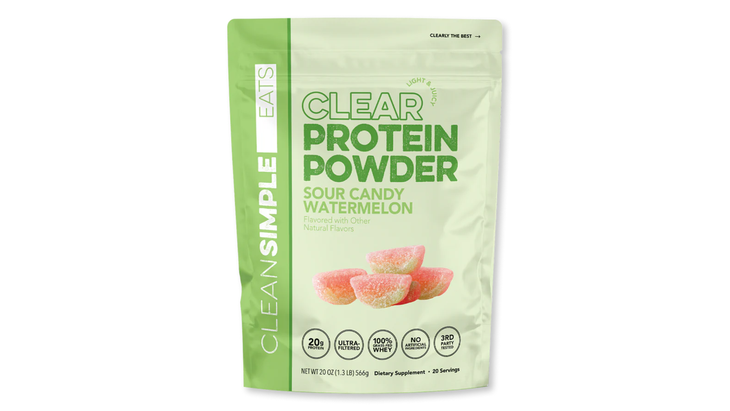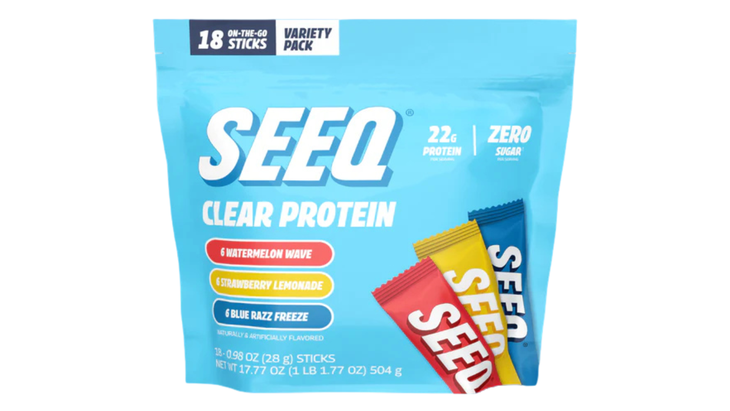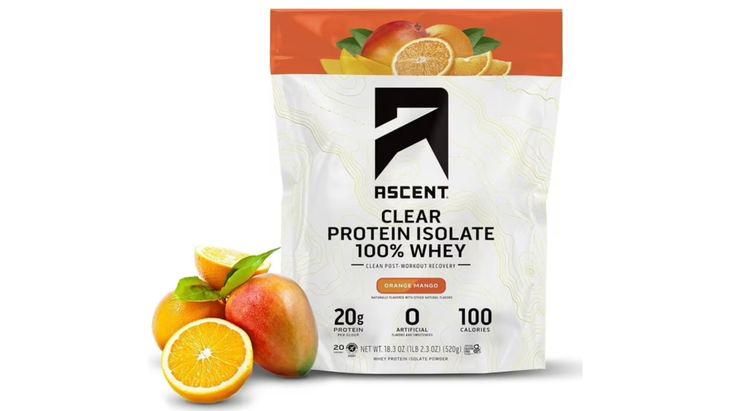Chuggable protein without the clumps? You better believe it. Clear protein is a trendy, fruity alternative to regular protein powder with less fat and carbs. A sports dietitian weighs in on the benefits and downsides, so the right choice for you is a little clearer.
Should runners use clear protein? A sports nutritionist breaks it down. (Photo: Getty Images)
Published September 25, 2025 12:36PM
Protein powders have historically been a very popular supplement, making it easier to nail protein goals. I frequently add a scoop or two to my diet, and if the sheer volume of protein powders on the market is any indication, I’m certainly not alone. But if the thought of another chalky, clumpy protein shake makes you want to run away from your post-workout refuel, you’re in luck. So-called “clear protein” is a trending alternative to the traditional protein powders with a similar promise to help you build more muscle and recover like a pro. It refers to protein powder that has a clear, transparent appearance when mixed with water or other liquids. Something that is shaking up the protein supplement world, so to speak.
The appeal is understandable: no creamy textures, no chalky aftertaste, no blender required. All you have to do is add water, shake, and you’ve got heaps of low-calorie protein and hydration wherever you might be. I can’t be alone in disliking drinking traditional whey protein powders with just water, and the range of clear protein flavors is now impressive, from peach tea to blueberry acai to yuzu. There’s truly something for every palate.
It sounds too good to be true—but is it? Let’s dig into the nuances of clear protein and whether it’s better for your health and fitness goals than the regular stuff.
What Exactly is Clear Protein Powder?
The main differences between clear protein and regular protein powders come down to the processing, taste, mixability, and texture. Unlike the creamy, milkshake-style protein powders you might have become accustomed to over the years, clear protein is a type of whey protein isolate (a byproduct of cheesemaking) that’s been filtered further to remove almost all fat, sugar, and, notably, lactose. The result is a lighter, often fruity, less opaque sports-drink-style tasting protein shake that’s far easier to mix with nothing more than water.
Gone is the milky sludge and mouth-coating texture in favor of a refreshing drink that goes down easy. That makes it ideal for those who don’t enjoy the texture or heaviness of traditional protein powders. It’s also great for those who want to avoid using a blender, as clear protein also avoids creating clumpy chunks of protein glued to the side of your shaker bottle or blender container. Some formulas will throw in extras like electrolytes or BCAAs.
Is Clear Protein Good for Runners?
You could easily argue that protein is the current darling of the nutrition world. It seems like everyone is obsessed with protein these days, as we are all gung-ho for protein-maxing in an attempt to get ripped. Certainly, runners can stand to benefit greatly by eating sufficient amounts of protein since it’s crucial for muscle repair and growth, both of which are important for being a more resilient athlete.
Current evidence suggests that endurance athletes should aim for up to 1.8 grams of protein per kilogram of body weight to properly adapt to training. That means a 160-pound runner can stand to benefit from taking in about 130 grams of protein each day. So, yes, a fair amount of this macro needs to be served up.
Protein Content: Clear vs. Whey
Clear protein is likely just as effective as regular whey protein when it comes to promoting muscle recovery and growth. Unfortunately, there are no studies to date comparing clear protein to other options, but being protein-dense with a favorable amino acid profile, my hunch is that runners can benefit just as much from using it as any other protein powder. In other words, no compromise here.
In fact, ultra-filtered clear whey isolate often contains more protein per 100g than many of its competitors, including whey concentrate or pea protein isolate, and its light texture and lack of fat and lactose mean it’s typically easier to digest, especially if you’re someone who struggles with dairy. Since people often mix it with water, clear protein is also a great post-run option for helping with rehydration efforts, which is especially important if you’ve been sweating a lot.
I’ve also noticed that drinks made with clear protein are less filling, which makes it easier to get your protein if you are feeling full. High-intensity exercise can suppress appetite for a period of time, which, in some athletes, can hinder recovery efforts. So if you struggle to get in enough nutrition after your tough runs, using clear protein could help.
Artificial Sweeteners
However, if you are blending traditional protein powders into smoothies with other ingredients like milk and frozen berries, you’ll be missing out on the nutrition that those items provide. It’s also worth noting that many brands use non-caloric sweeteners such as sucralose or stevia, which not everyone enjoys. (With less fat and natural sugar from milk that contribute to taste, clear-protein brands often rely more heavily on artificial flavorings and sweeteners for taste appeal.) This is problematic only if you already include a substantial amount of other drinks and foods that include these forms of sweeteners. I don’t fret if the only sucralose I’m getting in a day is from chugging back a shaker cup of watermelon clear protein, but just know that it’s easier to find traditional forms of protein powder made without artificial sweeteners than clear options.
Carbs, calories, and cost
While clear protein is marketed as having fewer carbohydrates and fats than regular whey protein, and therefore fewer calories, this difference is often marginal. Given that a typical whey protein isolate powder is about 90% protein, it’s already low in calories, carbs, and fat before being purified further.
Cost is another consideration. It can be more expensive than traditional protein powder. A higher degree of purification contributes to the higher price. So budget might be a deciding factor when choosing this style of protein powder.
If you are going plant-only with your diet, you are sadly out of luck, as clear protein only comes in whey form. But I’m sure that will change as somebody figures out how to turn peas into a strawberry protein powder that mixes with water like a hero.
How to Find the Best Clear Protein
With so many options on the market, choosing the right clear whey protein for you comes down to some of the finer details. Here are a few things to keep in mind.
Flavor: Of course, you will need to like the taste of the powder to want to use it. All of them pretty much taste like an electrolyte or sports drink, instead of a protein shake. The consistency of clear protein certainly lends itself to fruitier flavor profiles, unlike regular whey protein, which often comes in richer flavors like chocolate and vanilla. It mostly boils down to preference. Some may find that certain brands taste too, well, artificial. For newbies, opting for a familiar flavor like lemon might end up being the safest bet.
Protein: For the most part, careful label reading is not necessary when it comes to protein content. The majority of powders hover around 20 grams per serving, but some go a little higher. That’s certainly enough to help eat into your daily needs for this muscle-building macro.
Sweet stuff: Most brands make use of stevia or sucralose to give their product a sweet edge without including added sugar. If you’re sensitive to the aftertaste that these can impart, or question their healthfulness, you may want to look for an option that uses less of them or is formulated with real sugar.
Mixability: Clear proteins are designed with high solubility in mind, but some perform a bit better than others. I’ve noticed a few powders will foam up like a bubble bath and need some time to settle. Not a deal breaker unless you are very impatient.
So, Should Runners Use Clear Protein?
Ultimately, choosing between traditional and clear protein comes down to personal preference. If you’re after something fast, easy, and more refreshing, clear whey could be your new go-to. But if you find thicker smoothies made with regular protein powder more satisfying and don’t mind the extra work needed to whip it up, then there is no reason you can’t stick to the old ways. Both are equally good methods to help runners nail their daily protein needs, as long as you don’t mind their added cost. Realistically, the most effective protein source is one you’ll stick with.
While clear protein can be a great way to sneak in more protein, never think of it as a replacement for high-protein foods. It does not come close to providing the nutritional matrix that you’ll get from protein-rich foods like fish, tofu, eggs, yogurt, and poultry. If you are using more than 1-2 servings a day of the stuff to get the protein you need, it’s time to reevaluate your diet and start hunting out more wholesome ways to go bigger on the macro.
3 of the Best Clear Protein Powders
Even if you can chug it fast doesn’t mean you’ll want to. We sussed out three clear whey protein powders on the market, so you can have the ultimate big gulp.
Clean Simple Eats Sour Candy Watermelon

An ultra-filtered whey protein powder that tastes like everyone’s favorite pucker-inducing candy? Sold! Some of the finer points of this clear protein brand are the use of whey from grass-fed cattle, a juicy, non-gritty texture, tempered sweetness, and the absence of artificial sweeteners. The brand also uses third-party testing to assess for potency and the presence of contaminants. After a steamy workout, this is great to serve in a glass with plenty of ice.
Seeq Variety Pack

These single-serve packets make it even easier to get in more protein when on the go, whether on a plane or at the finish line. You get slightly more protein per serving than most others (22 grams instead of the standard 20), and the trio of fruit-forward flavors (strawberry lemonade, watermelon wave, and blue razz freeze) prevents flavor fatigue. They all taste a little too sweet for my preference, but I just ended up diluting each packet of protein with extra water to mellow things out. There is an added 4.5 grams of BCAAs, which may help build muscle and reduce soreness, and the silicone anti-foaming agent means less fuzz when you shake things up. Sucralose is used to sweeten the whey protein isolate, which might be off-putting for some who prefer a more natural approach to fueling.
Ascent Orange Mango

Ascent changes things up by sweetening its powder with a mix of organic cane sugar and stevia leaf extract, which gives it a more natural taste with less overpowering sweetness. At two grams of added sugar per serving, it can still be considered a low-sugar powder. The orange mango flavor has a refreshing edge that tastes like sunshine, and the powder mixes effortlessly. With the color of the powder hailing from vegetable juice, there is nothing sketchy there. The brand is geared toward hard-charging athletes, which might account for the higher amounts of sodium (from sea salt) to help replenish what we shed in sweat.














